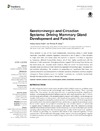Please use this identifier to cite or link to this item:
https://accedacris.ulpgc.es/handle/10553/21867
| DC Field | Value | Language |
|---|---|---|
| dc.contributor.author | Suárez-Trujillo, Aridany | en_US |
| dc.contributor.author | Casey, Theresa M. | en_US |
| dc.contributor.other | Suarez-Trujillo, Aridany | - |
| dc.date.accessioned | 2017-05-25T02:30:30Z | - |
| dc.date.accessioned | 2018-04-25T13:48:43Z | - |
| dc.date.available | 2017-05-25T02:30:30Z | - |
| dc.date.available | 2018-04-25T13:48:43Z | - |
| dc.date.issued | 2016 | en_US |
| dc.identifier.issn | 1664-042X | en_US |
| dc.identifier.uri | https://accedacris.ulpgc.es/handle/10553/21867 | - |
| dc.description.abstract | Since lactation is one of the most metabolically demanding states in adult female mammals, beautifully complex regulatory mechanisms are in place to time lactation to begin after birth and cease when the neonate is weaned. Lactation is regulated by numerous different homeorhetic factors, all of them tightly coordinated with the demands of milk production. | en_US |
| dc.format | application/pdf | es |
| dc.language | eng | en_US |
| dc.relation.ispartof | Frontiers in Physiology | en_US |
| dc.rights | by-nc-nd | es |
| dc.source | Frontiers in Physiology [ISSN 1664-042X], v. 7 (301) | en_US |
| dc.subject | 240113 Fisiología animal | en_US |
| dc.subject | 3109 Ciencias veterinarias | en_US |
| dc.subject.other | Serotonin | en_US |
| dc.subject.other | Circadian clocks | en_US |
| dc.subject.other | Mammary gland | en_US |
| dc.subject.other | Lactation | en_US |
| dc.subject.other | Home ostasis | en_US |
| dc.subject.other | Home orhesis | en_US |
| dc.title | Serotoninergic and circadian systems: driving mammary gland development and function | en_US |
| dc.type | info:eu-repo/semantics/Article | en_US |
| dc.type | Article | en_US |
| dc.identifier.doi | 10.3389/fphys.2016.00301 | |
| dc.identifier.scopus | 84981503274 | - |
| dc.identifier.isi | 000379733500001 | - |
| dcterms.isPartOf | Frontiers In Physiology | - |
| dcterms.source | Frontiers In Physiology[ISSN 1664-042X],v. 7 | - |
| dc.contributor.authorscopusid | 55572717800 | - |
| dc.contributor.authorscopusid | 35616075200 | - |
| dc.identifier.crisid | 27227;- | - |
| dc.relation.volume | 7 | - |
| dc.investigacion | Ciencias | en_US |
| dc.project.reference | FPU 12/06079; EST 14/00493 | es |
| dc.rights.accessrights | info:eu-repo/semantics/openAccess | es |
| dc.type2 | Artículo | en_US |
| dc.identifier.wos | WOS:000379733500001 | - |
| dc.contributor.daisngid | 4674080 | - |
| dc.contributor.daisngid | 304226 | - |
| dc.identifier.investigatorRID | P-4273-2016 | - |
| dc.contributor.wosstandard | WOS:Suarez-Trujillo, A | |
| dc.contributor.wosstandard | WOS:Casey, TM | |
| dc.date.coverdate | Julio 2016 | |
| dc.identifier.ulpgc | Sí | es |
| dc.description.sjr | 1,765 | |
| dc.description.jcr | 4,134 | |
| dc.description.sjrq | Q1 | |
| dc.description.jcrq | Q1 | |
| dc.description.scie | SCIE | |
| item.grantfulltext | open | - |
| item.fulltext | Con texto completo | - |
| crisitem.author.orcid | 0000-0002-9343-5016 | - |
| crisitem.author.fullName | Suárez Trujillo, Aridany | - |
| Appears in Collections: | Artículos | |
SCOPUSTM
Citations
14
checked on May 25, 2025
WEB OF SCIENCETM
Citations
11
checked on May 25, 2025
Page view(s)
106
checked on May 17, 2025
Download(s)
162
checked on May 17, 2025
Google ScholarTM
Check
Altmetric
Share
Export metadata
Items in accedaCRIS are protected by copyright, with all rights reserved, unless otherwise indicated.
